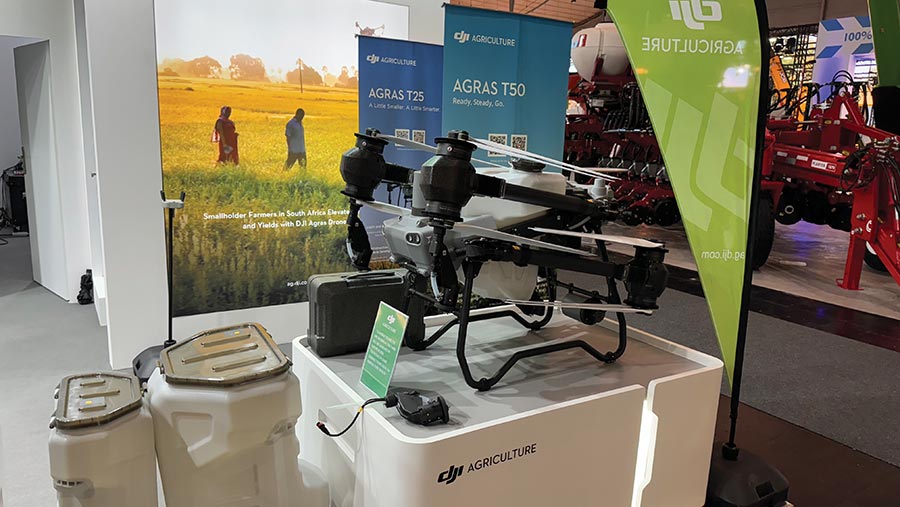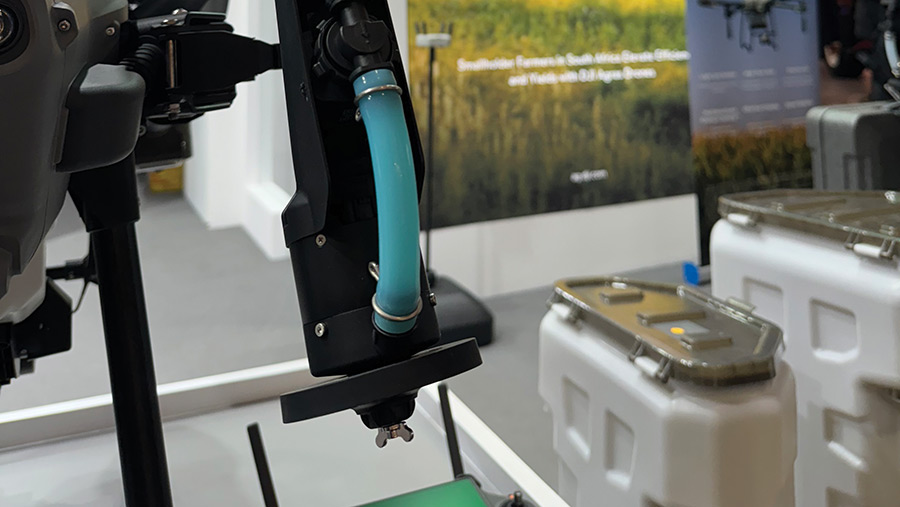Widespread adoption of drone spraying edges closer
 © Adam Clarke
© Adam Clarke China is leading the way on using drones to spray arable crops, and the presence of Chinese drone giant DJI’s agriculture division at the Agritechnica event in Hanover showed it is keen to flex its muscle in a market where it sees huge potential.
Up to now, Europe has lagged behind the US and China, but the sight of drones spraying arable crops may be getting closer, with signs that Europe is opening up regulation to permit their use.
DJI Agriculture has so far sold about 200,000 drones for spraying, 80% of which are in China.
See also: What are the prospects for spraying using drones in the UK?
It brought two new agricultural drone models and some of its top team from China to Agritechnica last month to discuss its research and development work and its collaboration with regulators to make the technology more accessible.

© Adam Clarke
Opening up
DJI Agriculture pointed to its latest annual Agricultural Drone Insight Report, published in August, which highlights a gradual opening up of regulation in Europe.
The EU Commission proposed an update to its Sustainable Use Directive in summer 2022, which will exempt some unmanned aerial vehicles from the 2009 law prohibiting aerial pesticide application.
This is because spraying drones – when used in conjunction with remote sensing technology to produce application maps – can be much more targeted and reduce overall pesticide use, which is a key goal for the EU’s Green Deal and Farm to Fork strategy.
Furthermore, the European Aviation Standards Authority ecently softened requirements for risk assessments when using a drone for a specific purpose such as chemical application, including lifting a 25kg weight limit, as long as it is within a maximum dimension of 3m.
Individual member states including Italy and France have already granted licenses for spraying of vineyards and orchards where steep slopes restrict access for ground sprayers.
Germany is also granting permission for agricultural drone use below 50kg.
In Switzerland, Agroscope, the country’s centre of excellence for agricultural research, has concluded that the environmental impact of using drones for spraying is similar to ground sprayers and has backed use of the technology.
Here in the UK, there is now a mechanism to get a permit for aerial spraying, with users able to submit application plans to the Health and Safety Executive for consideration.
The Health and Safety Executive is also leading a global partnership on how drones could be used to apply pesticides in the future.
This will help understand the risks to humans and the environment and adapt regulatory systems to better accommodate drone applications.

© Adam Clarke
Positive outlook
All this paints a positive outlook for drone spraying operations in Europe, and DJI Agriculture’s Zhong Wing tells Farmers Weekly that drones can complement existing spraying technology very well.
In the short term, this will mostly be on difficult terrain and for spot spraying applications, but she says efficiency of drones, in terms of hectares covered, can already compete with a medium-sized 18m boom sprayer.
With relatively short flight times on existing batteries, this would require multiple drones, batteries, a fast charger, and well-trained operators to achieve constant flight.
“On the other side is efficacy. A drone creates a downwash, which is something unique [to the technology] and makes better penetration [of the crop canopy].
“If you are spraying a crop with a thick canopy like potatoes, the downwash of the drone will push the droplets [to the target] better, so in some ways there is a possibility to replace ground sprayers in the future,” she explains.
DJI Agriculture is working with research organisations globally, including Auburn University in the US, to improve efficiency, efficacy and drift control when using drones.
Data on the latter is key to maintain momentum in opening up regulation where adoption is behind regions like Asia, such as in Europe.
“From the technical side, there is a lot we can do to change the regulatory ecosystem, like reducing drift by enhancing downwash, adding agents into the solution, and improving the precision of the systems,” explains Zhong.
Advanced technology
The first of two new DJI Agriculture drone models, the Agras T50 has been available in China since last year and is the largest and most advanced agricultural drone DJI has produced thus far.
Superseding the T40, the quadcopter has a coaxial dual rotor design with 54in blades and high-power electronic speed controllers (ESCs).
This means it is capable of flying at faster speeds while carrying a liquid spraying payload of 40kg and spreading (fertiliser or seeds) payload of 50kg.
Following the lead of other agricultural drone manufacturers, the unit moves away from hydraulic nozzles and uses centrifugal nozzles to deliver chemical to the target.
These have a motor-driven disc that rotates at high speed, dispersing spray droplets by centrifugal force. Droplet size is regulated by the speed of the disc and the flow rate from pump to nozzle.
Flow rates have improved dramatically compared with previous models, with 16 litres/min and 24 litres/min possible with two and four nozzles, respectively.
Its twin pump system is now integrated into the spray module rather than the drone, which makes cleaning and maintenance more straightforward.
If applying solid materials, the spreading module has an upgraded motor with increased torque and a spiral flow channel spinner which it is claims spreads more evenly and smoothly than before at rates up to 108kg/minute.
Improved camera
Other upgrades see the T50 carrying an ultra-high-definition first person view gimbal camera for better image collection and a powerful obstacle sensing system. This uses two phased array radars and two dual binocular vision systems front and rear.
Better LED spotlights also improve abilities when working at night and its combination of surveying and product application is claimed to make it a complete drone solution.
The second new model is the Agras T25P, which trumps the T20P model, and is a more flexible and portable option aimed at precision applications carried out by a single pilot on smaller farms.
Payload is 20kg for spraying and 25kg for spreading and the T25P benefits from all the other upgrades of the T50 for improved operation.
Neither DJI or its primary European distributor would say how much each drone might cost once on sale in 2024, but it’s likely to command a premium over €17,000 (£14,600) for a T30 package, which includes batteries, charger, and control system.
Given the cost and current regulatory roadblocks, will many be investing in agricultural drones from DJI and others in the short term?
ISO Standard
Joanna Wang, DJI Agriculture’s policy manager, says a recently published international standard (ISO23117) will help drone makers comply with a set of minimum requirements for reducing the risk of environmental issues when using drones for spraying.
Once agricultural drone models have this ISO certification, it will inevitably encourage regulators to permit their use where the country recognises the ISO standard.
Another significant roadblock is the agrochemical approvals in Europe, as almost all product labels will not include aerial spraying with drones as a means of application.
Joanna says there might be two routes for the EU and other countries including the UK to take.
One would be to follow the model used by Asia Pacific countries such as China and Thailand, which decided to permit use of most products applied with ground sprayers for drones.
The other is to follow the lead of Japan and have a separate list of registered products for drones, individually approved by the country’s health and safety regulators.
This would be a very heavy workload for the relevant department, but may be considered necessary here due to the use of low water volumes – meaning higher concentration of chemical in spray solutions – associated with drone spraying, for example.

